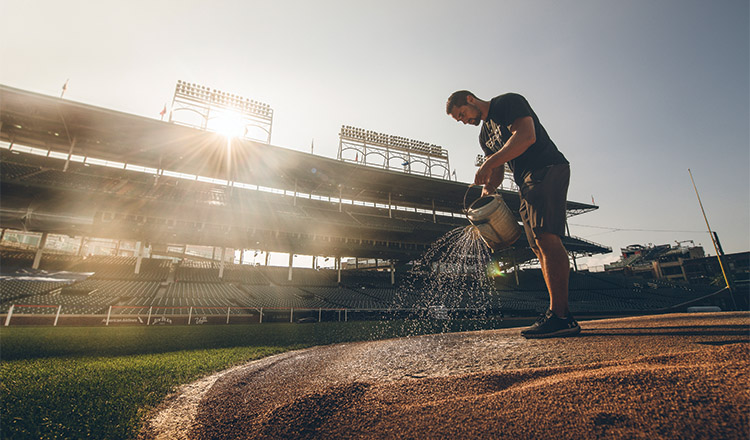Meet the sports turf managers who maintain America’s ballparks
You’ve heard of the seventh inning stretch? Joey Stevenson is a big fan of the fourth inning nap.
The head groundskeeper for the Indianapolis Indians keeps a pillow under his desk. Following the third inning drag, he checks the radar, and if skies are clear, he can grab a quick 35 minutes of shut-eye before he needs to prep for changing bases and dragging again in the sixth.
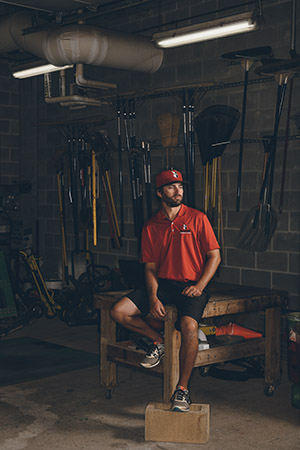
“In this industry, you’ve got to sleep when you can,” says Stevenson (A’06). “If I pull my chair in and position it right, no one can tell I’m down here. I can just take a little snooze under my desk. The crew leaves me alone. Nobody bothers me. It’s nice.”
During the season, Stevenson practically lives at the ballpark. His day starts 12 hours before the first pitch and ends an hour or two after the final out. His crew consists of one other full-time employee and two interns. On any given day, Stevenson will do everything from cleaning gum off the dugout floors to spraying $3,000 worth of fungicides to picking up sunflower seeds in the outfield to flipping the field after a rock concert.
“We think of ourselves as a 4A team,” Stevenson says. “We’re not quite big enough for the majors, but we’re the top of the 3A level. So we do a lot of the same things that the big leagues do — hold concerts on the field or extra events, but we still have the same small crew. Everyone has to pitch in and do everything to get it all accomplished.”
Stevenson is in his 11th season as director of field operations at Victory Field, recognized as the best minor league ballpark in America by prominent publications such as Baseball America and Sports Illustrated. He was 22 when he was promoted to the head position after serving one year as field operations manager.
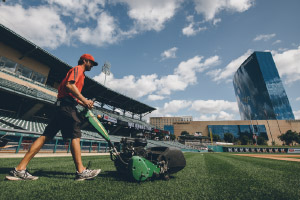
“I made a lot of mistakes in the beginning,” Stevenson says. “I didn’t know enough to be nervous or what was expected of me. I just wasn’t ready for the responsibility. I can remember sleeping in and missing a couple of tarp pulls in the morning.”
For a sports turf manager, that’s the stuff of nightmares. The tarp must be deployed within minutes. It doesn’t take much rainfall to soak the diamond and ruin the field. Leave it on too long in sunlight, and the lush, green grass becomes discolored and patchy or worse yet, diseased. Fans may appreciate groundskeepers for the fancy mowing patterns cut into the grass, but it’s the swift identification, treatment, and eradication of disease that’s necessary to maintain a professionally groomed field. Problem-solving a tricky diagnosis can keep a groundskeeper up at night.
“When I was hired, I thought I knew everything,” says Andrew Marking (A’15), head groundskeeper for the Quad Cities River Bandits in Davenport, Iowa. “I took one weekend off while it was hot and humid, and the turfgrass got a disease. It looked really rough for a month or so with a lot of dead spots in the infield. That was a gut punch.”
It’s not just the aesthetics that are worrisome when a fungal disease grabs hold of the turf. Serious issues can compromise the safety of the athletes and the playability of the field. A poor playing surface can affect the way a ball rolls, the direction it goes once it lands, or even a player’s footing during the game — any hole or irregularity could cause an injury. Caring for a ballpark requires meticulous attention to detail and constant monitoring. The transition from the grass to the infield skin — the dirt area around the bases — must be seamless, the chalk lines perfectly straight, the pitcher’s mound packed and precisely graded. It’s backbreaking physical labor, and the finished result remains pristine for only a fleeting moment.
“Once we get off the field for pregame, I’ll go up on the concourse before the first pitch, during the national anthem,” Marking says. “The way the field looks right then, before the catcher has knocked out the catcher’s box, when the foul lines are still freshly put down, that’s my favorite part of the day. When I go up there and say I had a hand in that,” Marking says.
Road to Wrigley
Dan Kiermaier (A’12) was 9 years old the first time he stepped foot in the Friendly Confines with his parents and two younger brothers. “I remember thinking that Wrigley Field was the coolest place in the world,” he says. “Little did I know that 20 years down the road I would be working here.”
Kiermaier grew up a Chicago Cubs fan. The 18-year-old family dog is named for former right fielder Sammy Sosa. Baseball is a bit of a family industry. Kiermaier’s younger brother Kevin is a star center fielder for the Tampa Bay Rays.
“Sports were always big for our family,” Kiermaier says. “We were hitting off a tee in the backyard at 3 years old. I played about the same level as everybody else, but Kevin just kept taking off. His talent was apparent. I really enjoyed playing, but I knew there wasn’t a future in that for me.”
Kiermaier’s future was uncertain when he enrolled at Purdue, the first in his family to go to college. He was undecided his first two years. Then he got into physical therapy and discovered he didn’t enjoy it. “I had no idea what I wanted to do with my life,” Kiermaier says. “I had a buddy who was studying turf science, and before I talked to him, I had no idea that was even a major. Turf struck an interest with me, so I just went all in and fell in love with every aspect of it.”
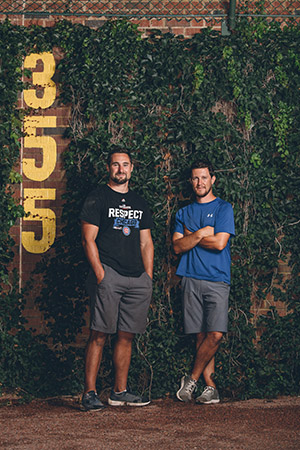
The turf management and science program graduates around 10 students each year with a 100 percent job placement rate upon graduation. Although the career trajectory has traditionally been associated with golf courses, the interest in sports turf management has increased in recent years.
“The level of professionalism of groundskeepers at stadiums and ballparks has risen dramatically over the past 15 years,” says Cale Bigelow, professor of horticulture and head of the program. “It’s not just someone in a shed with a mower. They are responsible for arguably the most important asset. They are the team behind the team.”
Turf managers must be well versed in soil science, plant nutrition, and pest management, but the job also requires fundamental knowledge of chemistry and meteorology. As supervisors, they’re charged with personnel management, budgeting, and vendor relations. It’s a diverse skill set that requires specialized training. The number of sports turf management jobs that demand a bachelor’s degree is growing. The US Bureau of Labor Statistics predicts a 20 percent increase in grounds maintenance work around the United States in the next decade.
“Sometimes you have to take jobs that aren’t necessarily perfect for you, but they’re going to help you get where you want to go,” says Kiermaier, who worked at the spring training facility Camelback Ranch in Phoenix, Arizona, before landing his dream job at Wrigley. “Once people get to the major leagues, they tend not to leave.”
Like all Cubs fans, Kiermaier saw a lifelong dream fulfilled when the team beat the Cleveland Indians four games to three to win the 2016 World Series. He worked games 3, 4, and 5 at Wrigley, and the Cubs organization flew the entire crew to the other four.
“To actually be there when they won after 108 years, it was a really special moment that I’ll never be able to duplicate,” Kiermaier says. Every member of the staff received a World Series ring. “It was a really nice gesture for the Cubs to give us all rings. I have something that connects me forever to a once-in-a-lifetime experience.”
Kiermaier’s loyalty to the Cubs is so fierce, it stands up against his love for his more famous younger brother. “If the Cubs and the Rays were to play in the World Series, I would have to root for the Cubs,” he says. “I would want Kevin to have a great series and light it up, but I’d still want us to win.”
And how does the turf at Tropicana Field compare to Wrigley? “Well theirs is artificial,” Kiermaier says, shaking his head. “Those guys do a good job with what they have, but I’m a proponent of natural grass fields.”
Love of the Game
Ben Baumer (A’14) considers himself pretty fortunate. He landed a major league groundskeeping gig at age 24, working alongside Kiermaier at Wrigley. “I love the city of Chicago,” Baumer says. “I like working outside, doing something that I love, and using my skills and talents in the profession that I studied in school.”

He may be lucky to be working one of the most coveted jobs in the industry, but his career trajectory had more to do with hard work than luck. Baumer always knew he wanted to work in sports turf management. His first gig was unpaid.
“My dad’s the superintendent of parks and recreation for the city of Batesville, Indiana,” Baumer says. “When I was in middle school, I’d help him out by tending to the same fields that I was playing on later that night.”
Baumer started working for a local landscaping outfit as a sophomore in high school. “That’s where I learned a lot of the little things you need to know to work in this industry,” he says. “Like how to drive a manual transmission, to back up a trailer, and to double check before you fill up equipment with regular gas or diesel fuel.”
It was Baumer’s dad who connected him with Stevenson at the Indianapolis Indians. Baumer expressed an interest in working part-time on the grounds crew, but there wasn’t a position available at the time. So he started as a bat boy just to get a foot in the door.
“I have always loved sports, so I was willing to start at the bottom to work my way up,” Baumer says. “It only lasted half a season before I was hired on to the grounds crew. I was still working for the landscaping company at that point, so I was doing that during the day, driving up to Indianapolis to work the Indians games until midnight, and then driving an hour and a half back down to Batesville.”
Before Baumer started college, he already had more experience than some students do by the time they graduate. His first job out of college was managing a high school sports complex. From there, he jumped to the major leagues. Now, he has a World Series under his belt, even if he doesn’t remember much of it.
“I wish I could have taken a step back to enjoy that time, but it was just a blur,” he says. “I did the pitcher’s mound that year, and I had to change out the pitching rubber after each home game so I was one of the last people to leave the ballpark. Normally one pitching rubber would last an entire season. The World Series was an exciting ride, but switching out the pitching rubber is what I will always remember.
“You have to have a passion for this industry,” Baumer says. “It’s not for everyone. We work 60 or 70 hour weeks. You miss family celebrations. I tell people I consider this work to be a hobby because I don’t have time for other hobbies out there.”
Change in Course
Zak Peterson (A’12) will never forget working his first game at Miller Park this April. Even though he had experience working on a national stage when he interned with the Texas Rangers during the 2011 World Series, the spring opener was his first as grounds manager for the Milwaukee Brewers. April is still winter in Wisconsin — Miller’s fan-shaped movable roof means games are played in all weather — so Peterson and his 40-person grounds crew had snow removal duties on top of prepping the field.
“I was nervous,” Peterson says. “As a supervisor there are so many moving parts to manage on game day. All the media is there. Your work will be broadcast on national TV. My wife and my mom made a sign that read, ‘We love the groundskeeper.’ That was a little embarrassing.”
There was a time when Peterson dreamed of the signs in the stands cheering for him as a player. Purdue recruited him as a pitcher, but he was injured his senior year of high school and underwent Tommy John surgery, ending his baseball career. At the time, it was crushing coincidence for the Peterson family. His dad had been recruited to play at the University of Colorado before its baseball program was dropped. So he returned to his hometown of McHenry, Illinois, to work at the family tire business. Faced with a similar situation, Peterson found himself at a crossroads.
“My grades in high school weren’t that great,” Peterson says. “The only reason I was accepted at Purdue was because of baseball. When that ended, I just thought, ‘Well, what could I do next?’”

It was Peterson’s father who suggested he channel his passion for the sport into groundskeeping. A first-generation college student, Peterson didn’t even know that was a major. His sophomore year, he started working at Ross-Ade Stadium with the Purdue Athletics grounds crew, and that’s when he fell in love with sports turf management. Peterson also interned with Stevenson at Victory Field.
“Turf managers are a close-knit community,” Peterson says. “Everybody knows everybody, and we bounce ideas off each other. We critique each other, too. When your work is visible on high definition TV, you’re going to see every little mistake, so that gets mentioned on social media. You don’t want to nitpick other people’s work. You never know what they had going on that week.”
Peterson still lives in McHenry, commuting more than an hour to work every day. It’s a minor inconvenience for the opportunity to live out his major league dreams.
“A bad day at the ballpark beats a good day anywhere else,” Peterson says. “I try not to take it for granted. Yes, you’re coming to work, but you’re on a national stage every day for your job. That’s pretty cool.”
For those who love being outdoors and don’t mind getting dirty, the turf management and science program offers a refreshing alternative to the daily grind. “Our unofficial motto is ‘ditch the desk job,’” Bigelow says. “The type of person who is attracted to this career — their soul would be crushed in a cubicle.”
A Cut Above
Those fancy designs groundskeepers mow into the field? They’re not just for looks. Switching up the mowing pattern helps prevent rutting and promotes a healthy turf with a smooth, clean cut. To create the decorative green-hued designs, groundskeepers use mowers, rollers, and even hand tools to deliberately alter the angles of grass blades relative to sunlight.
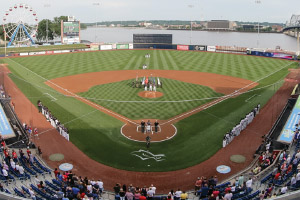
Banks of the Mississippi 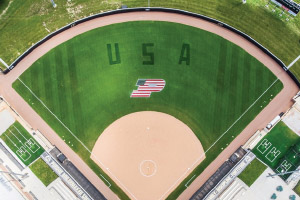
Red, white, and Purdue
Grass mowed away from the viewer reflects light, giving off a lighter tone. Mow the other direction, and the shadows cast give the grass its rich, dark green color. The colors will switch if you move to the other end of the ballpark. The higher up your viewpoint, the more dynamic the contrast.
The Sports Turf Managers Association encourages its members to show off their creativity with its annual Stars and Stripes field design contest. Ryder Haulk, assistant sports field manager for Purdue Athletics, won the 2018 competition with his Red, White, and Purdue design at Bittinger Stadium that included 50 stars and 13 stripes within the Motion P logo. It’s the second year in a row a Purdue-affiliated turf manager took top honors. Andrew Marking (A’15), head groundskeeper for the Quad City River Bandits, won in 2017 with his Banks of the Mississippi River design.
“As a sports turf manager, crafting a safe playing surface is always our primary concern, but this contest provides groundskeepers an opportunity to express themselves on a global stage,” says Marking. “We also have a duty to maintain visually appealing facilities year-round for the millions of fans watching.”

